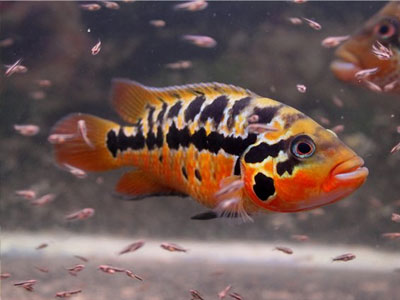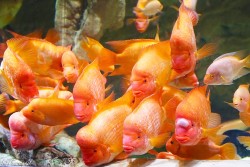Red Tiger Motaguense for Sale (Parachromis motaguensis)

Red Tiger Motaguense - The Vibrant Cichlid Hybrid
The Red Tiger Motaguense is a stunning man-made hybrid cichlid that first emerged in the late 1990s. It was likely created by crossing the red devil cichlid, midas cichlid, and the jaguar cichlid. The result is a brightly colored fish with an imposing appearance.
As their name suggests, Red Tiger Motaguenses exhibit a deep orange-red coloration overlaid with bold black striping and spotting reminiscent of a tiger. Some specimens also display pearlescent white spotting across the body and fins, which can highlight in yellow or green under light.
A brawny, stocky body shape coupled with their fierce patterning gives Red Tiger Motaguenses a formidable look. Despite intimidating appearances, most are relatively peaceful in a well-decorated aquarium with appropriate tank mates and without cramped conditions.
These hybrids can reach up to 14 inches in captivity. Given their substantial size and some territorialism, especially during spawning, a 100 gallon tank or larger is recommended. While unable to naturally breed, Red Tiger Motaguenses make stunning display fish. Their vibrancy demands attention against any backdrop.

Red Tiger Motaguense for Sale (Parachromis motaguensis)
Common Name: Red tiger motaguense
Scientific Name: Parachromis motaguensis
Other names: Motagua cichlid
Family: Cichlidae
Distribution: Central american: honduras, Atlantic slope of Guatemala. El Salvador
Diet: These fish are oppurtunistic piscivores and enjoy soft rayed fish such as live bearers and goldfish. Hikari gold pellets, krill and fish meat are great meals for these fish.
Water temperature: 68-84 degrees Fahrenheit (20-28 c)
Water chemistry: 7.0-8.0 ph soft to medium hardness
Lifespan: 10+ years
Minimum recommended tank size: Single specimen should be kept in a 75g. Pairs should be kept in 125g with divider close by, and with tankmates a 180g is necessary. Pairs should be kept alone unless tank exceeds 1000g.
Nomenclature: This fish belongs to the genus Parachromis which describes the Central American guapotes. Before this they were listed under cichlasoma and were commonly referred to as their cousins Cichlasoma friedrichsthali when first imported back in the early-mid 60's. The mota got its name because of its type locality which is the Rio motagua. Hence Motaguense. Also alot of confusion concerning the Parapetenia genus have come up and this was found written by Dr. Loisellei in 1980: The genus Parachromis is an assemblage of medium-sized to very large Heroine cichlid species characterized by large, obliquely placed, more or less strongly protractile jaws. Regan (1905), then considering these species as part of the Cichlasoma subgroup Parapetenia, recognized a gradation of specialization with regard to the elaboration of the enlarged pseudocanines teeth in the anterior portion of both jaws. In the most advanced forms, the anteriormost pair of pseudocanines in the upper jaw are greatly enlarged, the posterior two pairs decreasing progressively in size. In the lower jaw, the pattern is reversed, producing a highly efficient mechanism for seizing and holding the small fish upon which these cichlids prey. Regan himself apparently felt that his initial definition was a bit too broad and subsequently re-assigned some nominal Parapetenia to other subgenera (1907) a trend continued by Eigenmann (1924), who moved the three representatives of the group from northwestern South America to the subgenus Astateros. The genus Parachromis as presently understood comprises mainly the more specialized piscivores originally placed in Parapetenia by Regan.
Species Description: The mota is a gorgeous guapote, considered by many to be the most attractive in the family. Surprisingly enough, its popularity is nowhere near that of its close cousins the Managuense and dovii. The males of this species reach lengths of up to 12" while females are more around 8-10". They have a yellowish gold back ground with brownish red speckles across the body and several black blotches running down the center of the body to the tail. The mota's reputation is well deserved. These fish can be down right nasty. The temperament of these fish is only outdone by the dovii in the guapote group. Tankmates should be chosen with caution as long as there is only a single specimen. Breeding pairs should be absolutly kept alone. Tankmates would include silver dollars, tinfoil barbs, plecos, and other larger similar temperamental cichlids as long as PLENTY of space is given. The mota like all other guapotes are equipped with pseudocanine's. Combine these with the males explosive ferocious, quick attacks, bad temper, and you have yourself a dangerous fish capable of dispatching tank mates with ease. Something very unique about the guapotes particularly the motaguense along with dovii and managuense, is that when in captivity, and fed live fishes, they will continue to capture prey but instead of attempting to swallow them, they will keep the fish in their mouths' gradually working them backward into the throat while the digestive process progresses.
Sexing: Sexing the mota is increasingly difficult the younger the specimen. The female once mature, will have more red on her gill plate and throughout the body in general when compared to the male, and the male will be larger.
Breeding: Breeding of these fish tend to be just like all other guapotes. The female and male both enter a "breeding dress" and the coloring of both intensify especially that of the female. She gets a lot more reds and yellows than normal. Courting of both fish includes head quivering, jaw locking, gill flaring, lunging at one another without physical contact. The pair will clean off a piece of slate supplied in the tank and depending on the females maturity she may lay anywhere from 500-3000 eggs with the male following up to fertilize them. As with most cichlids the female takes on the duty of fanning the eggs and the male hovers over the perimeter keeping a Hawkeye out and ambush on anything that moves. The eggs will hatch after about 3 day's and the young will be fed organic matter sifted out of the substrate. They become free swimming 4-7 day's after hatching and are now able to be fed baby brine, crushed flake, cyclops, and daphnia. A warning to any keepers that aren't experienced, cleaning of the tanks at this time is not recommended if the male is over 7" because he can and will put those pseudocanines to use and its not uncommon to see these fish launch themselves out of their tank for airborne attacks on human fingers and forearms. This behavior is typically only displayed a week or two after the start of the free swimming stage. At this point no matter what size tank you have unless its a good couple thousand gallons. Any and all tankmates you may have had in with them, wont be in there anymore. At least...not alive.
Misc.: If looking for the motaguense be careful of buying them as motaguense and ending up with loisellei or friedrichsthali and vice versa with them all, as they are very similar in shape and pattern to their close cousins.
Recommended dry foods for Motaguense cichlids
This recommended guide for Motaguense cichlid dry foods includes veggies sticks, carnivore sticks, general pellets, bug bites, and krill. This provides a nice broad range of foods for health and growth.
YFS Veggie Supreme Sticks contains high amounts of veggie content. The perfect choice for veggie loving South American cichlids.
YFS Carnivore Sticks are a hearty sinking stick great for all of those bigger hungrier fish. To that we added kelp, spirulina and natural astaxanthin for great natural color.
NorthFin Cichlid Formula is professionally developed to improve the health and well-being of your Cichlids and other freshwater fish, while naturally enhancing their brilliant colors.
Fluval Bug Bites Cichlid Formula for Medium to Large Fish 3.5oz is specifically formulated to address the natural, insect-based feeding habits of fish, with added vitamins, minerals, and other trace nutrients important to their health and vitality.
NorthFin Krill Pro Pro Formula is easily digestible, slow-sinking pellets promote optimal nutrient absorption and help reduce the amount of waste in your aquarium.



